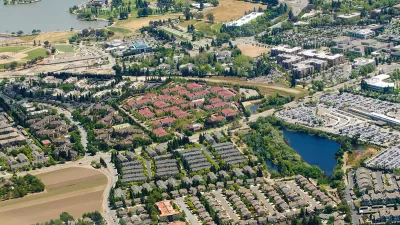Most attempts to regulate suburban development have focused on containing the growth of suburban housing. But such regulation, by restricting the supply of buildable land, risks incresing housing prices. And from a more libertarian perspective, an individual's interest in choosing to "drive to qualify" may seem quite appealing. Attempts to regulate commercial suburban development do not involve the same sentimental considerations as limits on residential development, but do risk increasing prices for commercial land, thus increasing prices for everything else.
Most attempts to regulate suburban development have focused on containing the growth of suburban housing. But such regulation, by restricting the supply of buildable land, risks incresing housing prices. And from a more libertarian perspective, an individual's interest in choosing to "drive to qualify" may seem quite appealing. Attempts to regulate commercial suburban development do not involve the same sentimental considerations as limits on residential development, but do risk increasing prices for commercial land, thus increasing prices for everything else.
But these considerations do not justify the form of suburban office parks. I can think of no reason why an office building (other than, perhaps, one where the Ebola virus is routinely handled) should be behind a 500-foot driveway with no sidewalks. The arguments for allowing offices to locate in suburbia do not justify the office park form, because 500-foot driveways do not reduce rents in any obvious respect.
Moreover, the suburban office park in its current form creates harmful externalities, by forcing people to drive to reach them even if they live nearby (thus increasing pollution and traffic congestion).
It logically follows that office buildings should be fair game for public regulation, in all but the most libertarian jurisdictions. Quite simply, any building in an area zoned for offices should be required to be within five or ten feet of a functional sidewalk, so that a pedestrian or transit user can reach the office without endangering life or limb.
In addition, any collection of office buildings should be on grid streets rather than cul-de-sacs. The traditional justification for cul-de-sacs is to protect families from cut-through traffic. But this justification does not apply to an office building, since office buildings by definition create traffic to a much greater extent than do single-family homes.

Planetizen Federal Action Tracker
A weekly monitor of how Trump’s orders and actions are impacting planners and planning in America.

Map: Where Senate Republicans Want to Sell Your Public Lands
For public land advocates, the Senate Republicans’ proposal to sell millions of acres of public land in the West is “the biggest fight of their careers.”

Restaurant Patios Were a Pandemic Win — Why Were They so Hard to Keep?
Social distancing requirements and changes in travel patterns prompted cities to pilot new uses for street and sidewalk space. Then it got complicated.

Platform Pilsner: Vancouver Transit Agency Releases... a Beer?
TransLink will receive a portion of every sale of the four-pack.

Toronto Weighs Cheaper Transit, Parking Hikes for Major Events
Special event rates would take effect during large festivals, sports games and concerts to ‘discourage driving, manage congestion and free up space for transit.”

Berlin to Consider Car-Free Zone Larger Than Manhattan
The area bound by the 22-mile Ringbahn would still allow 12 uses of a private automobile per year per person, and several other exemptions.
Urban Design for Planners 1: Software Tools
This six-course series explores essential urban design concepts using open source software and equips planners with the tools they need to participate fully in the urban design process.
Planning for Universal Design
Learn the tools for implementing Universal Design in planning regulations.
Heyer Gruel & Associates PA
JM Goldson LLC
Custer County Colorado
City of Camden Redevelopment Agency
City of Astoria
Transportation Research & Education Center (TREC) at Portland State University
Camden Redevelopment Agency
City of Claremont
Municipality of Princeton (NJ)






























